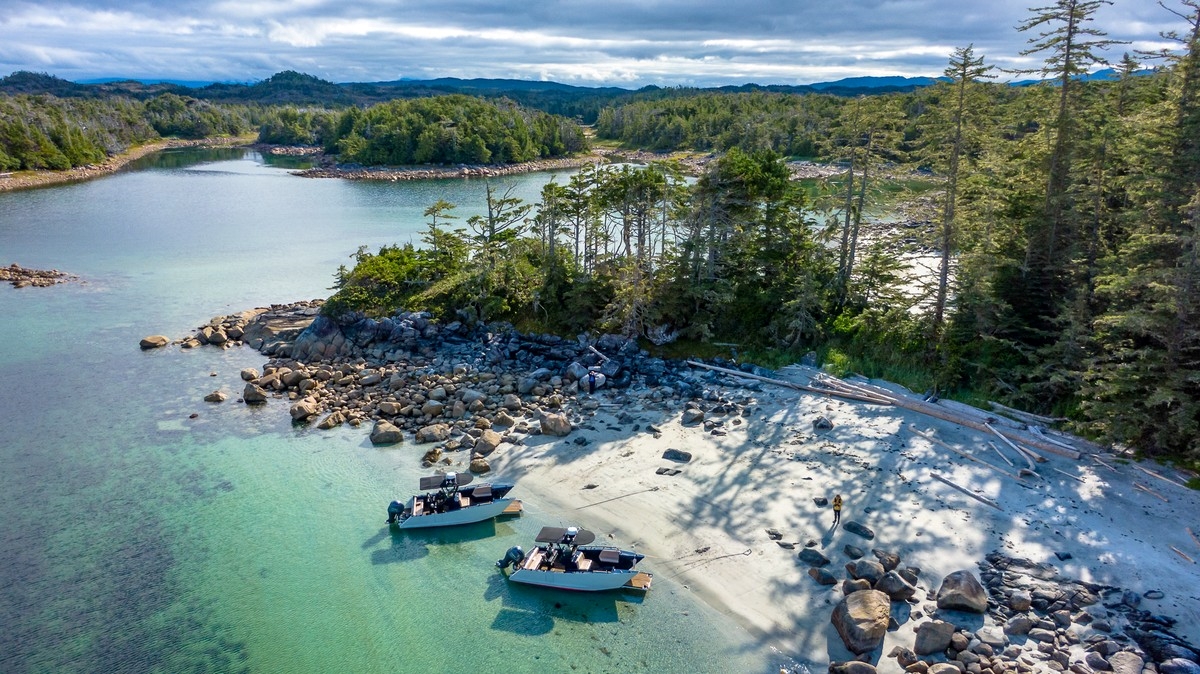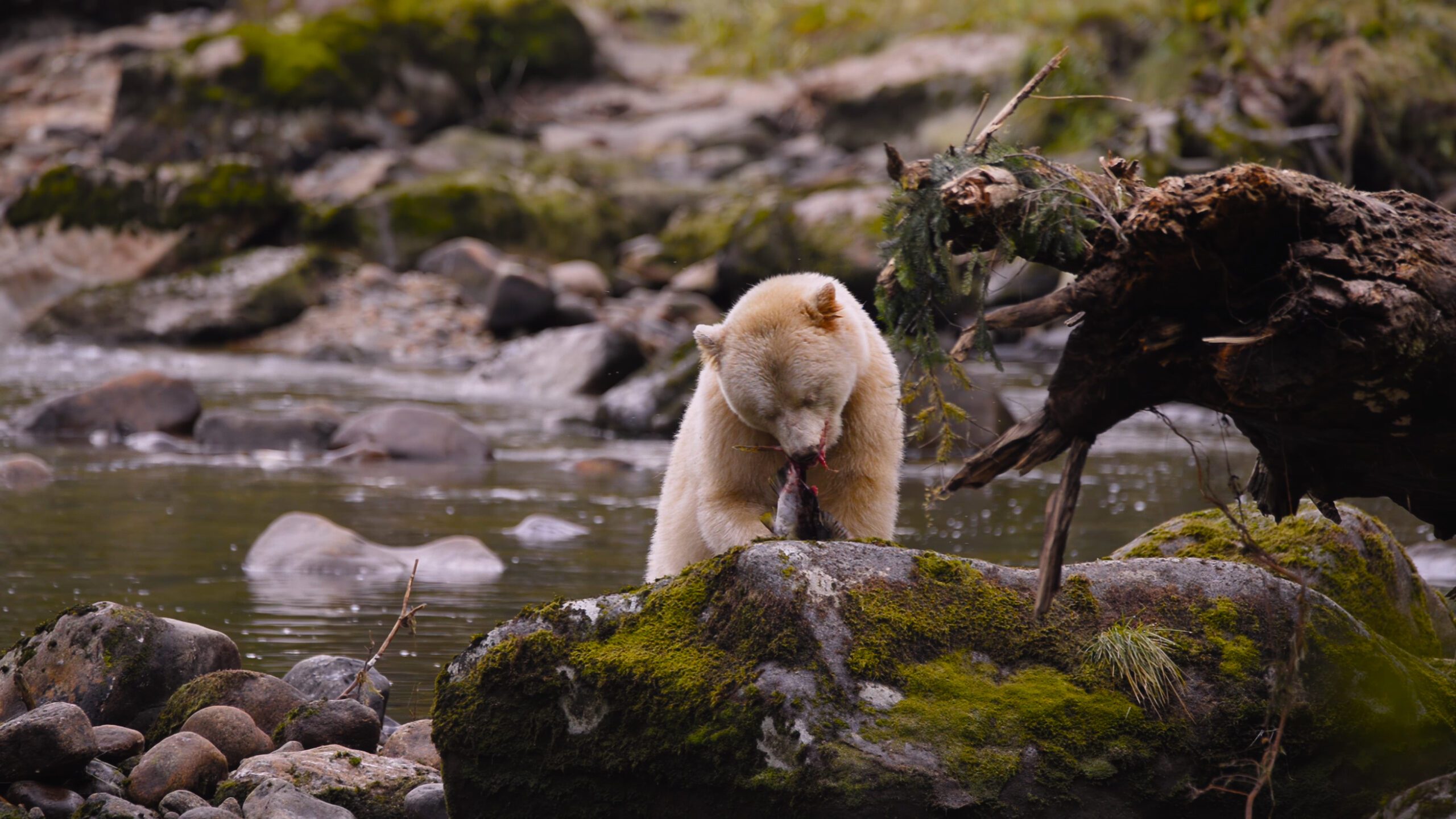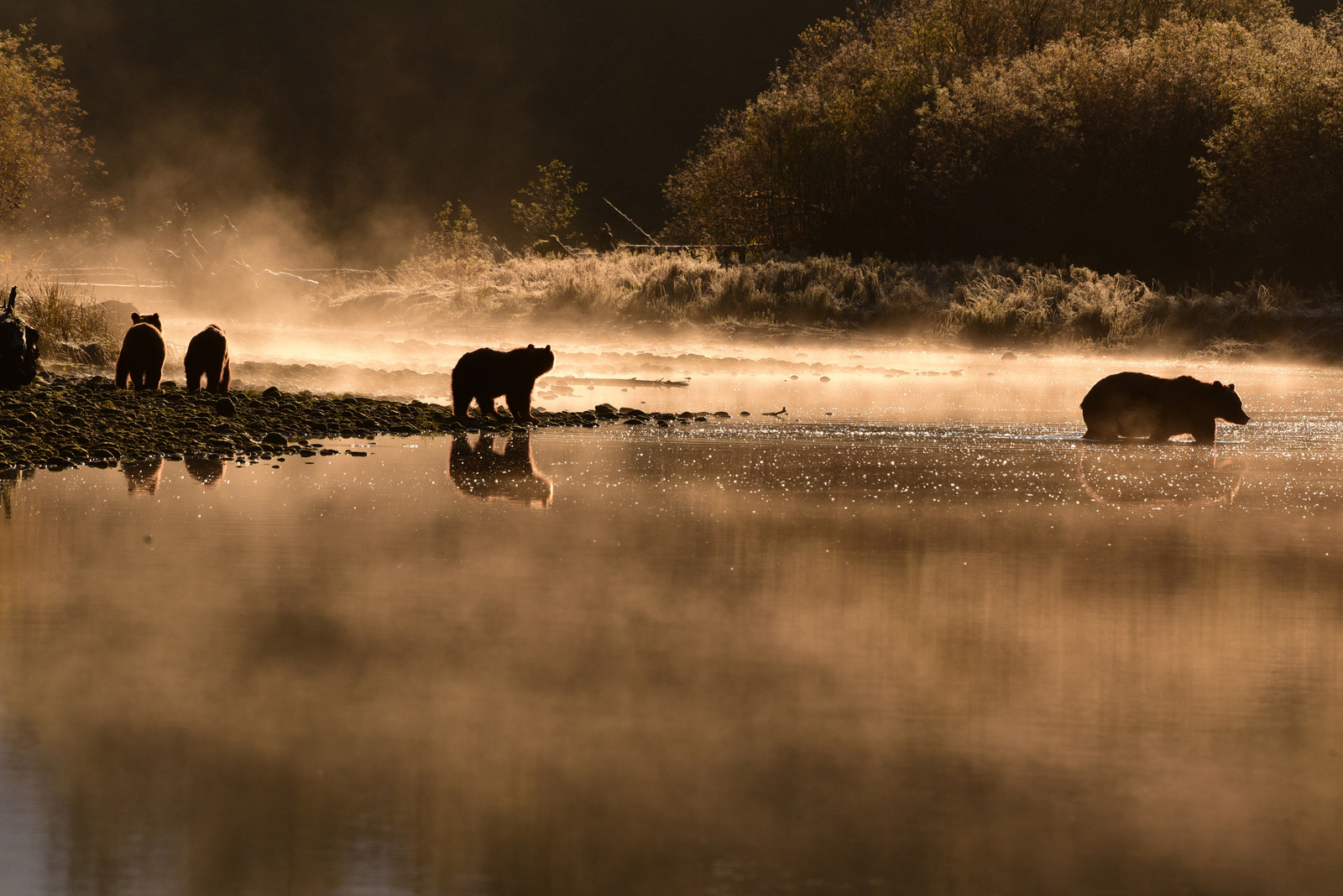
Points of Interest

Ports
Great Bear Rainforest and Kitlope
Wild Wonders That We Have Explored and Supported Since 1986
Cruise through dramatic coastal mountains into the stunning Kitlope River. Here, snow-capped peaks tower over estuaries where bears* graze on sedge in spring or fish for salmon in late summer. Join knowledgeable crew on shore excursions to explore the Kitlope River Estuary, relax on secluded beaches, trek through ancient rainforests, and discover the area’s historical significance.
Itinerary Details
- Ships: Maple Leaf, Swell or Cascadia
- Duration: 7, 8 or 9 Days
- Ports: Kitimat
- Spirit Bears are not a feature of this trip
Great Bear Rainforest and Kitlope
- Swell or Maple Leaf
- 7 Days
Sample Itineraries: As with all expedition cruises, the itinerary may change based on weather, wildlife activity, and interests of the guests. This itinerary is to give you a general idea of the trip.
Day 1: Board ship at Kitamaat Village, orientation, cruising into the Great Bear Rainforest, making way towards the Kitlope River, watching for marine mammals and birds. Anchorage at remote hot springs.
Day 2: Cruise to spectacular mainland inlet estuary popular with grizzly and black bears. Estuary meadow walk (wildflowers), learning about bear habitat, river exploration, look for bears.
Day 3: Morning exploration ashore, then cruising Whale Channel, an aptly named waterway popular with cetaceans. Visit whale research scientists at remote station. Marine mammal viewing (several species). Anchorage at remote island on west coast. Beachcombing, hike to view, beach fire.
Day 4: Return to mainland waterways between steep islands, through channel popular with whales. Enter Gardner Canal, the longest fjord on the coast. This waterway seems like remote wilderness but is filled with the stories and history of the Henaaksiala people, and around every turn is a new story, including some sasquatch stories, and Monkey Beach.
Day 5: Sail deep into the coast mountains, leaving the outside world behind as the fjord snakes past 4,000-foot peaks to the Kitlope. Go ashore in the vast Kitlope River & estuary for the amazing tale of the G’psgolox pole. Explore the river and the estuary.
Day 6: Further exploration in the Kitlope, and/or or cruise to Kowesas to explore ashore, and then Kemaano shore trip. Cruise to hot springs.
Day 7: Cruise to Kitamaat, watching for wildlife.
Departures
Find ideal trip dates for our Great Bear Rainforest and Kitlope Tour below. All prices are listed in Canadian dollars. For other itineraries and departures, switch the tabs above.
| Date | Price | # of Nights | Start Port | End Port | Ship |
|---|---|---|---|---|---|
| June 2 – 9, 2026 | $6,000 | 7 | Kitimat | Kitimat | Maple Leaf |
| June 11 – 17, 2026 | $7,450, $8,150, $9,550 | 6 | Kitimat | Kitimat | Swell |
| May 28 – June 3, 2027 | $5,300 | 6 | Kitimat | Kitimat | Maple Leaf |
| June 9 – 15, 2027 | $7,680, $8,390, $9,850 | 6 | Kitimat | Kitimat | Swell |
* Prices are all-inclusive, and subject to a $200 sustainability fee per person. The trips in Canada are subject to 5% federal tax. See “Included in Our Price” for the exceptional value included. Fares are per person, based on double occupancy, and in Canadian dollars. For solo travellers, there is no single supplement on the SV Maple Leaf trips (shared accommodation), and there is a 50% single supplement on the MV Swell and Cascadia trips. For full-ship private charters, please contact us. Payment and cancellation policy is available online, in the brochures and by speaking with us. We welcome your contact.
Great Bear Rainforest Kitlope Supervoyage
- Cascadia
- 8 Days
Sample Itineraries: As with all expedition cruises, the itinerary may change based on weather, wildlife activity, and interests of the guests. This itinerary is to give you a general idea of the trip.
Day 1: Board ship at Kitamaat Village, orientation, cruising into the Great Bear Rainforest, making way towards the Kitlope River, watching for marine mammals and birds. Anchorage at remote hot springs.
Day 2: Cruise to spectacular mainland inlet estuary popular with grizzly and black bears. Estuary meadow walk (wildflowers), learning about bear habitat, river exploration, look for bears.
Day 3: Morning exploration ashore, then cruising Whale Channel, an aptly named waterway popular with cetaceans. Visit whale research scientists at remote station. Marine mammal viewing (several species). Anchorage at remote island on west coast. Beachcombing, hike to view, beach fire.
Day 4: Return to mainland waterways between steep islands, through channel popular with whales. Enter Gardner Canal, the longest fjord on the coast. This waterway seems like remote wilderness but is filled with the stories and history of the Henaaksiala people, and around every turn is a new story, including some sasquatch stories, and Monkey Beach.
Day 5: Sail deep into the coast mountains, leaving the outside world behind as the fjord snakes past 4,000-foot peaks to the Kitlope. Go ashore in the vast Kitlope River & estuary for the amazing tale of the G’psgolox pole. Explore the river and the estuary.
Day 6: Cruise to Kowesas to explore ashore and then the site of Kemaano. Cruise to hot springs.
Day 7: Whale watching and exploring further sites along the fjord. Visit second hot springs.
Day 8: Cruise to Kitimat. Wildlife viewing en route.
Departures
Find ideal trip dates for our Great Bear Rainforest and Kitlope Tour below. All prices are listed in Canadian dollars. For other itineraries and departures, switch the tabs above.
| Date | Price | # of Nights | Start Port | End Port | Ship |
|---|---|---|---|---|---|
| August 23 – 29, 2026 | $8,300, $9,770, $11,150 | 6 | Kitimat | Kitimat | Cascadia |
| August 18 – 25, 2027 | $8,715, $10,260, $11,710 | 7 | Kitimat | Kitimat | Cascadia |
* Prices are all-inclusive, and subject to a $200 sustainability fee per person. The trips in Canada are subject to 5% federal tax. See “Included in Our Price” for the exceptional value included. Fares are per person, based on double occupancy, and in Canadian dollars. For solo travellers, there is no single supplement on the SV Maple Leaf trips (shared accommodation), and there is a 50% single supplement on the MV Swell and Cascadia trips. For full-ship private charters, please contact us. Payment and cancellation policy is available online, in the brochures and by speaking with us. We welcome your contact.
What People Say
See what our guests have to say about our Great Bear Rainforest and Kitlope tours.
Highlights
Every Day Is an Extraordinary Event
Sacred to the Haisla and known as Xesdu’wäxw (Huschduwaschdu), meaning “blue, milky, glacial water,” the Kitlope is the largest contiguous tract of protected temperate rainforest on the planet.
Related Stories
Follow our coastal expeditions with notes from the field.
Frequently Asked Questions
Answers to your questions about our Great Bear Rainforest Spring itineraries. Refer to our Frequently Asked Questions for more general trip and booking information.
To reach Kitimat you can fly Pacific Coastal Airlines through Vancouver Airport (YVR). For flights arriving into Kitimat, we will arrange to pick you up at the airport and shuttle you to the ship. For trips ending in Kitimat, transport is arranged back to the airport along with other guests on your tour.
Our schedule is designed to accommodate incoming flights on the day of departure and most guests will arrive on the day. But, if you would like to arrive a little early to avoid the stress of possible flight delays, you will find recommendations for local hotels and activities in your welcome aboard package.
In late spring (May and June), the Kitlope experiences mild temperatures ranging from 10°C to 17°C (50°F to 63°F). Rain is common, contributing to the lushness of the region, so it’s advisable to bring layered clothing and waterproof gear. While weather can be unpredictable, spring offers a captivating atmosphere to explore the diverse ecosystems. Check local forecasts before your trip for the most up-to-date information on weather conditions.
Late summer in the Kitlope is typically warmer and drier, with temperatures ranging from 13°C to 20°C (55°F to 68°F). The days are generally pleasant, making it an ideal time for outdoor activities. Rainfall is a characteristic feature of the rainforest, so be prepared for occasional showers or drizzles. It’s a good idea to pack rain gear and clothing suitable for varying weather conditions. Keep an eye on forecasts before your trip for the most up-to-date information on weather conditions.
Yes, spring is a great time to visit the Kitlope. The landscape is vibrant with new growth, and the estuaries are bustling with wildlife. Bears and cubs are often seen grazing on sedge during this time, and the region’s rainforests are especially lush. Wildflowers carpet the meadows, and migratory birds return to the region. The temperate climate during May and June offers comfortable weather for outdoor activities, such as hiking or hot springs.
Absolutely. Summer offers warmer, more stable weather, making it perfect for exploring the Kitlope’s natural beauty aboard our small ship, tenders and kayaks. Migratory whales tend to be very active this time of year, and from late-August bears start to return from the mountains to the estuaries, fishing for salmon in the rivers. The relatively drier conditions make hiking and beach visits more enjoyable.
No, spirit bears are not typically found in the Kitlope. While the area is rich in wildlife, the spirit bear’s primary habitat is located in other parts of the Great Bear Rainforest. This means you should plan to come on a September of October Great Bear Rainforest tour if you are interested in seeing a spirit bear.
There’s a fair (but not guaranteed) chance of spotting bears in the Kitlope during the late summer. If your main goal is to see bears, you may have better success during the spring or fall, when most bears return to lower elevations to feed on sedges or salmon. Summer on the other hand offers increased opportunity to see migratory sea mammals such as humpback whales, orcas, and if lucky, coastal wolves. Our experienced guides will do their best to enhance wildlife viewing opportunities and share knowledge of local wildlife.



